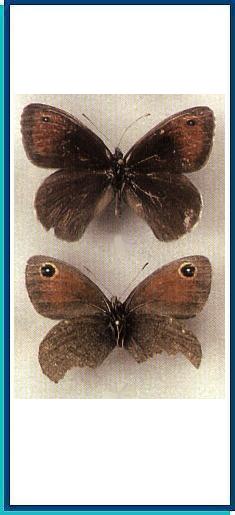LEPIDOPTERA
S A T Y R I D A E Boisduval, 1833
PARALASA Moore, 1893
Paralasa horaki Tuzov, 1997
Paralasa horaki Tuzov, 1997

· HOLOTYPE: Kirghizia, Alaisky Mts., Iordan, 2,500 m a.s.l., 8.07.1984, leg. A. Horak
· PARATYPE: Kirghizia, Alaisky Mts., Aksu Valley, Kara-Shoro, 2,200 m a.s.l., 22.07.1992, leg. V. Tuzov.
The type specimens are deposited in the collections of the State Darwinian Museum and V. Tuzov.
· DESCRIPTION. Male (holotype). FW length 25 mm (paratype 26 mm). Head and palpi black. Antennae black; club spindle-shaped, flattened, reddish-brown, its side facing the wing white. UPS ground colour dull brown. FW termen slightly convex; apex rounded. FW with a sharply outlined broad reddish-brown band, beginning from vein R5, tapering towards dorsum and ending between veins Cu2 and A2, about 2 mm away from termen. A black white-centred ocellus, 1.5-2 mm in diameter, lying on band between veins R5 and M1, closer to termen. A rounded androconial field, faint and diffused, lying in cell slightly closer to its end than to base. Androconial scales trident-shaped at ends, their bases flat. UPH unmarked. Fringes brown, grey at base. UNS ground colour same as that of UPS. UNF central area with a diffuse cherry-brown spot reaching the wing base. Ocellus larger than on UPS, 3-4 mm, elongate, centred with two pupils (rounded and single-centred in the paratype), narrowly ringed with yellow. UNH with whitish superscaling, darker towards wing base; a well-defined series of white dots along termen.
Male genitalia . Uncus curved and pointed, slightly shorter than tegumen. Branches of gnathos strongly curved upwards, equal to uncus or slightly shorter. Clasp narrow, with a variable number of strong teeth on distal side; distal end flattened, with small teeth on its sides. Aedeagus straight, with an expansion closer to a spine-free distal end.
· RANGE. The Alaisky Mts.
· TAXONOMIC NOTES. So far only two specimens of this species are available. Judged from the general appearance, the presence of bands on the UPS and the genitalic structure, it must be assigned to the mani-group.
· HABITAT AND BIOLOGY. Flight in the same habitats as P. semenovi, viz. huge vertical rock walls at 2,000-2,500 m a.s.l. Flight period: July.
· SIMILAR SPECIES. P. maracandica: FW apex rounded; UPH always with a red-brown band; UNS ocelli smaller; male without androconial spot.
Photo and text: Guide to the BUTTERFLIES OF RUSSIA and adjacent territories Volume 1. PENSOFT, Sofia - Moscow. 1997